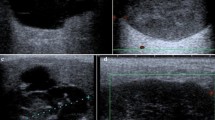Abstract
Background
American Thyroid Association (ATA) guidelines suggest that thyroidectomy can be delayed in some children with multiple endocrine neoplasia syndrome 2A (MEN2A) if serum calcitonin (Ct) and neck ultrasonography (US) are normal. We hypothesized that normal US would not exclude a final pathology diagnosis of medullary thyroid cancer (MTC).
Methods
We retrospectively queried a MEN2A database for patients aged <18 years, diagnosed through genetic screening, who underwent preoperative US and thyroidectomy at our institution, comparing preoperative US and Ct results with pathologic findings.
Results
35 eligible patients underwent surgery at median age of 6.3 (range 3.0–13.8) years. Mean MTC size was 2.9 (range 0.5–6.0) mm. The sensitivity of a US lesion ≥5 mm in predicting MTC was 13 % [95 % confidence interval (CI) 2 %, 40 %], and the specificity was 95 % [95 % CI 75 %, 100 %]. Elevated Ct predicted MTC in 13/15 patients (sensitivity 87 % [95 % CI 60 %, 98 %], specificity 35 % [95 % CI 15 %, 59 %]). The area under the receiver operating characteristic curve (AUC) for using US lesion of any size to predict MTC was 0.50 [95 % CI 0.33, 0.66], suggesting that US size has poor ability to discriminate MTC from non-MTC cases. The AUC for Ct level at 0.65 [95 % CI 0.46, 0.85] was better than that of US but not age [AUC 0.62, 95 % CI 0.42, 0.82].
Conclusions
In asymptomatic children with MEN2A diagnosed by genetic screening, preoperative thyroid US was not sensitive in identifying MTC of any size and, when determining the age for surgery, should not be used to predict microscopic MTC.

Similar content being viewed by others
References
Pelizzo M, Boschin I, Bernante P, et al. Natural history, diagnosis, treatment and outcome of medullary thyroid cancer: 37 years experience on 157 patients. Eur J Surg Oncol. 2007;33:493–7.
Donis-Keller H, Dou S, Chi D, et al. Mutations in the RET proto-oncogene are associated with MEN 2A and FMTC. Hum Mol Genet. 1993;2:851–6.
Mulligan L, Kwok J, Healey C, et al. Germ-line mutations of the RET proto-oncogene in multiple endocrine neoplasia type 2A. Nature. 1993;363:458–60.
Skinner MA, Moley JA, Dilley WG, et al. Prophylactic thyroidectomy in multiple endocrine neoplasia type 2A. N Engl J Med. 2005;353:1105–13.
Kloos RT, Eng C, Evans DB, et al. Medullary thyroid cancer: management guidelines of the American Thyroid Association. Thyroid. 2009;19:565–611.
Grubbs EG, Waguespack SG, Rich TA, et al. Do the recent American Thyroid Association (ATA) guidelines accurately guide the timing of prophylactic thyroidectomy in MEN2A? Surgery. 2010;148:1302–10.
Elisei R, Romei C, Renzini G, et al. The timing of total thyroidectomy in RET gene mutation carriers could be personalized and safely planned on the basis of serum calcitonin: 18 years experience at one single center. J Clin Endocrinol Metab. 2012;97:428–35.
Rohmer V, Vidal-Trecan G, Bourdelot A, et al. Prognostic factors of disease-free survival after thyroidectomy in 170 young patients with a RET germline mutation: a multicenter study of the Groupe Francais d’Etude des Tumeurs Endocrines. J Clin Endocrinol Metab. 2011;96:E509–18.
Brandi ML, Gagel RF, Angeli A, et al. Guidelines for diagnosis and therapy of MEN type 1 and type 2. J Clin Endocrinol Metab. 2001;86:5658–71.
Waguespack SG, Rich TA, Perrier ND, et al. Management of medullary thyroid carcinoma and MEN2 syndromes in childhood. Nat Rev Endocrinol. 2011;7:596–607.
Raval MV, Sturgeon C, Bentrem DJ, et al. Influence of lymph node metastases on survival in pediatric medullary thyroid cancer. J Pediatr Surg. 2010;45:1947–54.
Punales MKC, Possatti da Rocha A, Meotti C, et al. Clinical and oncological features of children and young adults with multiple endocrine neoplasia type 2A. Thyroid. 2008;18:1261–8.
Machens A, Lorenz K, Dralle H. Individualization of lymph node dissection in RET (rearranged during transfection) carriers at risk for medullary thyroid cancer: value of pretherapeutic calcitonin levels. Ann Surg. 2009;250:305–10.
Modigliani E, Cohen R, Campos J-M, et al. Prognostic factors for survival and biochemical cure in medullary thyroid carcinoma: results in 899 patients. Clin Endocrinol. 1998;48:265–73.
Machens A, Schneyer U, Holzhausen H-J, et al. Prospects of remission in medullary thyroid carcinoma according to basal calcitonin level. J Clin Endocrinol Metab. 2005;90:2029–34.
Deveci MS, Deveci G, LiVolsi VA, et al. Concordance between thyroid nodule sizes measured by ultrasound and gross pathology examination: effect on patient management. Diagn Cytopathol. 2007;35:579–83.
Rodrıguez Gonzalez JM, Balsalobre MD, Pomares F, et al. Prophylactic thyroidectomy in MEN 2A syndrome: experience in a single center. J Am Coll Surg. 2002;195:159–166.
Cai S, Liu H, Li WB, et al. Ultrasonographic features of medullary thyroid carcinoma and their diagnostic values. Chin Med J. 2010;123:3074–8.
Choi N, Moon W-J, Lee JH, et al. Ultrasonographic findings of medullary thyroid cancer: differences according to tumor size and correlation with fine needle aspiration results. Acta Radiol. 2011;52:312–6.
Lee S, Shin JH, Han B-K, et al. Medullary thyroid carcinoma: comparison with papillary thyroid carcinoma and application of current sonographic criteria. Am J Roentgenol. 2010;194:1090–4.
Acknowledgment
The University of Texas MD Anderson Cancer Center is supported in part by a cancer center support grant (CA16672) from the National Institutes of Health. Dr. Grubbs was supported by an American Cancer Society Mentored Research Scholar Grant for MEN2 (121138MRSGM1112901).
Disclosures
We have no financial or commercial interests to disclose.
Author information
Authors and Affiliations
Corresponding author
Rights and permissions
About this article
Cite this article
Morris, L.F., Waguespack, S.G., Edeiken-Monroe, B.S. et al. Ultrasonography Should Not Guide the Timing of Thyroidectomy in Pediatric Patients Diagnosed with Multiple Endocrine Neoplasia Syndrome 2A through Genetic Screening. Ann Surg Oncol 20, 53–59 (2013). https://doi.org/10.1245/s10434-012-2589-7
Received:
Published:
Issue Date:
DOI: https://doi.org/10.1245/s10434-012-2589-7



